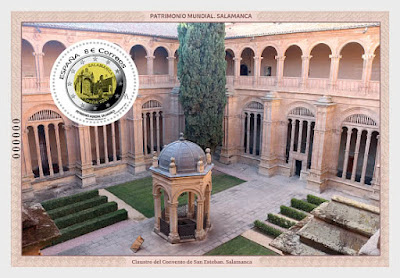3845) Salamanca, Convent of San Esteban de Salamanca - A World Heritage Site, Spain: Espana de Correos (Spanish Post) has issued an intaglio stamp which reproduces the 2-Euro coin issued by the Royal Mint and the stamp featuring the Convent which is part of the UNESCO World Heritage Sites in Spain: Date/Year of 24.03.2025:
About World Heritage Site - Salamanca, Convent of San Esteban de Salamanca: 24.03.2025:
Since 2010, Correos Espana (Spanish Post) has been issuing the "World Heritage Series", which combines philately and numismatics in a single element. The intaglio stamp reproduces the 2-Euro coin issued by the Royal Mint and the stamp.
This year, 2025, the focus is on Salamanca, whose Old City has been recognised as a UNESCO World Heritage Site since 1988.
The façade of the Convent of San Esteban was chosen to illustrate the coin depicted on the stamp, and the arches of the cloister are featured in the background of the block sheet, depicting the interior of the convent.
The Convent of San Esteban is a convent belonging to the Order of Preachers or Dominicans. The current building was built between 1524 and 1610.
The façade of the church is one of the most beautiful examples of Spanish Plateresque architecture. In its central section, the depiction of the Martyrdom of Saint Stephen by Juan Antonio Ceroni stands out, and above this image, a Calvary by the same artist can be seen.
The Church of Saint Stephen has a Latin cross layout and a single nave with an altarpiece by José de Churriguera, as well as the side chapel dedicated to Our Lady of the Rosary.
The Soto staircase is striking for its innovative technique for the 16th century, as the lower section supports the entire structure and rests only on the walls, without bearing its weight on them.
Christopher Columbus travelled here to meet with the prior of the convent, Fray Diego de Deza, who was Isabella the Catholic's confessor. His goal was to convince the Dominicans to finance his voyage to the Indies.
Adds the Book titled "TREASURES OF THE WORLD" (A Book on UNESCO World Heritage Sites{ in my Personal Library/Collection:
"Old City of Salamanca:
Salamanca is one of the key centres of a dynasty of architec ts, decorators and sculptors from Catalonia, the Churriguera.
The Churrigueresque style also exerted considerable influence in the eighteenth century in the countries of Latin America. However, the city owes its most essential features to its university.
The remarkable group of buildings in the Gothic, Renaissance and Baroque styles which, from the fifteenth to the eighteenth centuries, grew up around the institution that proclaimed itself "Mother of Virtues, of Sciences and of the Arts".
The University had already edstablished itself by 1250 as one of the best in Europe. The oldest university building in Salamanca, now the Rectorate, is the former Hospital del Estudio, built in 1413.
The main university buildings, Las Escuelas Mayores, are grouped around a centrasl patio and were built between 1425 and 1433.
Beginning with the Roman bridge that spand the Rio Tormes southwest of the city, numerous witnesses to the history of Salamanca still stand: the Old Cathedral and San Marcos (twelfth century), the Salina and the Monterray palaces (sixteenth century), and the Plaza Mayor, the most sumptious of the Baroque squares in Spain (eighteenth century)."
The Stamps:
A Collectible.
Links:
The Clipper - Cutty Sark:



Rajan Trikha has commented:
ReplyDelete"Very informative,"
Thank you Trikha sahab.
DeleteSantosh Khanna has commented:
ReplyDelete"A VERY interesting and informative post Thanks for sharing."
Thank you so much Khanna sahab
Delete